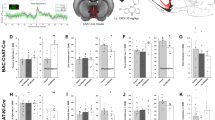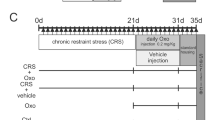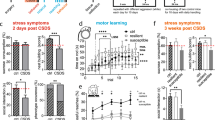Abstract
Pyridostigmine, a carbamate acetylcholinesterase (AChE) inhibitor, is routinely employed in the treatment of the autoimmune disease myasthenia gravis1. Pyridostigmine is also recommended by most Western armies for use as pretreatment under threat of chemical warfare, because of its protective effect against organophosphate poisoning2,3. Because of this drug's quaternary ammonium group, which prevents its penetration through the blood–brain barrier, the symptoms associated with its routine use primarily reflect perturbations in peripheral nervous system functions1,4. Unexpectedly, under a similar regimen, pyridostigmine administration during the Persian Gulf War resulted in a greater than threefold increase in the frequency of reported central nervous system symptoms5. This increase was not due to enhanced absorption (or decreased elimination) of the drug, because the inhibition efficacy of serum butyrylcholinesterase was not modified5. Because previous animal studies have shown stress–induced disruption of the blood–brain barrier6, an alternative possibility was that the stress situation associated with war allowed pyridostigmine penetration into the brain. Here we report that after mice were subjected to a forced swim protocol (shown previously to simulate stress7), an increase in blood–brain barrier permeability reduced the pyridostigmine dose required to inhibit mouse brain AChE activity by 50% to less than 1/100th of the usual dose. Under these conditions, peripherally administered pyridostigmine increased the brain levels of c–fos oncogene and AChE mRNAs. Moreover, in vitro exposure to pyridostigmine increased both electrical excitability and c–fos mRNA levels in brain slices, demonstrating that the observed changes could be directly induced by pyridostigmine. These findings suggest that peripherally acting drugs administered under stress may reach the brain and affect centrally controlled functions.
This is a preview of subscription content, access via your institution
Access options
Subscribe to this journal
Receive 12 print issues and online access
$209.00 per year
only $17.42 per issue
Buy this article
- Purchase on Springer Link
- Instant access to full article PDF
Prices may be subject to local taxes which are calculated during checkout
Similar content being viewed by others
References
Taylor, P. Cholinergic agonists. and Anticholinesterase agents. in The Pharmacological Basis of Therapeutics, 8th edn (eds. Gilman, A.G., Rall, T.W., Nies, A.S. & Taylor, P.) 122–130, 131–147 (Pergamon, New York, 1990).
Deyi, X., Linxiu, W. & Shuqiu, P. The inhibition and protection of cholinesterase by physostigmine and pyridostigmine against soman poisoning in vivo . Fundam. Appl. Toxicol. 1, 217–221 (1981).
Diruhumber, P., French, M.C., Green, D.M., Leadbeater, L. & Stratton, J.A. The protection of primates against soman poisoning by pretreatment with pyridostigmine. J. Pharmacol. 31, 295–299 (1979).
Borland, R.G., Breman, D.H. & Nicholson, A.N. Studies on the possible central and peripheral effects in man of a cholinesterase inhibitor (pyridostigmine). Hum. Toxicol. 4, 293–300 (1985).
Sharabi, Y. et al. Survey of symptoms following intake of pyridostigmine during the Persian Gulf War. Isr. J. Med. Sci. 27 656–658 (1991).
Sharma, H.S., Cervos-Navarro, J. & Dey, P.K. Increased blood–brain barrier permeability following acute short-term swimming exercise in conscious normotensive young rats. Neurosci. Res. 10, 211–221 (1991).
Melia, K.M., Ryabinin, A.E., Schroeder, R., Bloom, F.E. & Wilson, M.C. Induction and habituation of immediate early gene expression in rat brain by acute and repeated restraint stress. J. Neurosci. 14, 5929–5938 (1994).
Ben Aziz-Aloya, R. et al. Expression of a human acetylcholinesterase promoter-reporter construct in developing neuromuscular junctions of Xenopus embryos. Proc. Natl. Acad. Sci. USA 90, 2471–2475 (1993).
Blick, D.W. et al. Acute behavioral toxicity of pyridostigmine or soman in primates. Toxicol. Appl. Pharmacol. 126, 311–318 (1994).
Friedman, A. & Gutnick, M.J. Intracellular calcium and control of burst generation in neurons of guinea-pig neocortex in-vitro . Eur. J. Neurosci. 1, 374–381 (1989).
Glickson, M. et al. The influence of pyridostigmine on human neuromuscular functions — studies in healthy human subjects. Fundam. Appl. Toxicol. 16, 288–298 (1991).
Ekstrom, T.J., Klump, W.M., Getman, D., Karin, M. & Taylor, P. Promoter elements and transcriptional regulation of the acetylcholinesterase gene. DNA Cell Biol. 12, 63–72 (1993).
Ehrhart-Bornstein, M. et al. Adrenaline stimulates cholesterol side-chain cleavage cytochrome P450 mRNA accumulation in bovine adrenocortical cells. J. Endocrinol. 131, 5–8 (1991).
Brust, P. Blood–brain-barrier transport under different physiological and pathophysiological circumstances including ischemia. Exp. Pathol. 42, 213–219 (1991).
Harik, S.I. & Kalaria, R.N. Blood–brain-barrier abnormalities in Alzheimer's disease. Ann. N. Y. Acad. Sci. 640, 47–52 (1991).
Agnoli, A., Martucci, N., Manna, V., Conti, L. & Fioravanti, M. Effect of cholinergic and anticholinergic drugs on short term memory in Alzheimer's dementia: A neuropsychological and computerized electroencephalographic study. Clin. Neuropharmacol. 6, 311–323 (1983).
Iwasaki, Y., Wakata, N. & Sinoshita, M. Parkinsonism induced by pyridostigmine. Acta Neurol. Scand. 78, 236 (1988).
Loewenstein-Lichtenstein, Y. et al. Genetic predisposition to adverse consequences of anti-cholinesterases in ‘atypical’ BCHE carriers. Nature Med. 1, 1082–1085 (1995).
Whittaker, M. Cholinesterases. Monogr. Hum. Genet. 65–85 (1986).
Schwarz, M., Click, D., Loewenstein, Y. & Soreq, H. Engineering of human Cholinesterases explains and predicts diverse consequences of administration of various drugs and poisons. Pharmacol. Ther. 67, 283–321 (1995).
Brown, D.A. Slow cholinergic excitation - a mechanism for increasing neuronal excitability. Trends Neurosci. 6, 302–306 (1983).
McEwen, B.S. & Sapolsky, R.M. Stress and cognitive function. Curr. Opin. Neurobiol. 5, 205–216 (1995).
Gavaghan, H. NIH panel rejects Persian Gulf syndrome. Nature 369, 8 (1994).
Ben-Nathan, D., Lustig, S. & Danenberg, H.D. Stress-induced neuroinvasiveness of a neurovirulent noninvasive Sindbis virus in cold or isolation subjected mice. Life Sci. 48, 1493–1500 (1991).
Neville, L.F., Gnatt, A., Padan, R., Seidman, S. & Soreq, H. Anionic site interactions in human butyrylcholinesterase disrupted by two single point mutations. J. Biol. Chem. 265, 20735–20738 (1990).
Seidman, S. et al. Synaptic and epidermal accumulations of human acetylcholinesterase are encoded by alternative 3′-terminal exons. Mol. Cell. Biol. 15, 2993–3002 (1995).
Uyama, O. et al. Quantitative evaluation of vascular permeability in the gerbil brain after transient ischemia using Evans blue fluorescence. J. Cerebral Blood Flow Metab. 8, 282–284 (1988).
Rachinsky, T.L. et al. Molecular cloning of mouse acetylcholinesterase: Tissue distribution of alternatively spliced mRNA species. Neuron 5, 317–327 (1990).
Author information
Authors and Affiliations
Rights and permissions
About this article
Cite this article
Friedman, A., Kaufer, D., Shemer, J. et al. Pyridostigmine brain penetration under stress enhances neuronal excitability and induces early immediate transcriptional response. Nat Med 2, 1382–1385 (1996). https://doi.org/10.1038/nm1296-1382
Received:
Accepted:
Issue Date:
DOI: https://doi.org/10.1038/nm1296-1382
This article is cited by
-
Pathophysiological basis and promise of experimental therapies for Gulf War Illness, a chronic neuropsychiatric syndrome in veterans
Psychopharmacology (2023)
-
Microglia and their LAG3 checkpoint underlie the antidepressant and neurogenesis-enhancing effects of electroconvulsive stimulation
Molecular Psychiatry (2022)
-
Effects of centrifugation and whole-body vibrations on blood–brain barrier permeability in mice
npj Microgravity (2020)
-
Real-time in vivo two-photon imaging study reveals decreased cerebro-vascular volume and increased blood-brain barrier permeability in chronically stressed mice
Scientific Reports (2018)
-
α7 nicotinic acetylcholine receptor signaling modulates the inflammatory phenotype of fetal brain microglia: first evidence of interference by iron homeostasis
Scientific Reports (2017)



